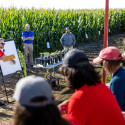Two-way turn lane improves safety
Statistics show that four-lane undivided roadways are generally the most unsafe of all roadways. The typical solution? Widen the highway and add a median.
Now, thanks to research by University of Wisconsin–Madison assistant professor Keith Knapp, civil and environmental engineering, statistics also show that reducing roadways from four lanes to three can result in acceptable mobility and increased safety but also reduced costs and the need to encroach on neighboring land.
The three-lane alternative includes one lane in each direction and a two-way, left- turn lane. Knapp has been researching the safety and operational impacts of conversion projects completed throughout the United States.
Such conversions cannot be applied as an across-the-board approach without considering a variety of factors pertaining to operational and safety issues and community goals, Knapp explains.
He has written several papers and developed award-winning guidelines that identify factors that should be considered before such “context-sensitive” design decisions are made.
His investigation indicates that safety at conversion locations has increased while maintaining the level of operational service. The sites reviewed experienced a relatively dramatic reduction in excessive speeding and total crashes.
Knapp’s simulation analyses shows only a slight decrease in “through” vehicle average speed for a large range of peak-hour traffic volumes, access densities, and access-point left-turn volume.
Tags: research




